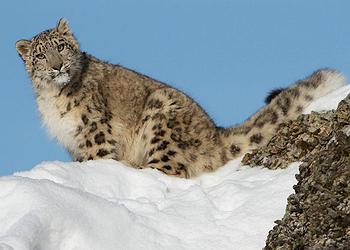
NEW YORK, New York, July 24, 2013 (ENS) – The vast highlands and open spaces of China, Tibet and Mongolia – once roamed by snow leopards, wild camels and yaks, Tibetan gazelles, wild sheep and goats – are increasingly dominated by domestic goats that produce hair for the lucrative cashmere trade. Soft and warm, cashmere scarves and sweaters, and cashmere-wool blend coats and suits fetch top prices in exclusive shops.
A study released today by the New York-based Wildlife Conservation Society and Seattle-based Snow Leopard Trust demonstrates a link between the cashmere trade and the decay of ecosystems that support some of the planet’s little-known large mammals.
With 90 percent of the world’s cashmere sourced from China and Mongolia, the study finds that as pastoralists expand their goat herds, wildlife from the Tibetan Plateau to Mongolia suffer.

Mammal species at risk include the Critically Endangered wild Bactrian camel, Camelus ferus, and the Critically Endangered Mongolian saiga, Saiga tatarica, an antelope that historically was a common species across Eurasian steppes and semi-deserts.
Endangered mammals at risk are the Tibetan antelope called chiru, Pantholops hodgsonii, and the native wild horse, Equus ferus przewalskii.
Classed as Near Threatened, the argali sheep, Ovis ammon, is also impacted by the cashmere trade, as are two species of Least Concern, the blue sheep called bharal, Pseudois nayaur; and the ibex, Capra sibirica, a species of wild goat.
Endangered snow leopards, Panthera uncia, that prey on these species are also at risk.
The growth in goat herds has brought increasing conflicts with pastoralists, predation by dogs on wildlife, retaliatory killing of snow leopards, and displacement of wildlife away from critical food habitats, the study shows.
The study appears in the August issue of the journal “Conservation Biology.” Joel Berger, a biologist for the Wildlife Conservation Society and professor at University of Montana, shares authorship with Bayarbaatar Buuveibaatar of Wildlife Conservation Society Mongolia, and Charudutt Mishra of the Snow Leopard Trust.
“The consequences are dramatic and negative for iconic species that governments have signed legislation to protect, yet the wildlife is continually being squeezed into a no-win situation,” says Berger. “Herders are doing what we would do – just trying to improve their livelihoods, and who can blame them?”
“Cashmere production is a complicated human issue. Understandably, indigenous herders are trying to improve their livelihoods, but the short-term economic gain is harming the local ecosystem,” explains Mishra.
“By improving our understanding of the relationship between indigenous herders, local ecology and global markets, we can implement policies at the national and international level which are better designed to protect biodiversity while supporting the livelihoods of local communities,” he says.

The study results from fieldwork in India, western China, and Mongolia and builds upon economic data including herder profits, changes in livestock numbers, and the relative abundance of wildlife.
Its purpose is to raise awareness among western consumers about the origins of cashmere and its growing impact on wildlife. The authors suggest that the study should serve as the beginning of a dialogue among the garment industry, cashmere herders, and conservationists to address and mitigate these impacts.
Wildlife Conservation Society has begun to help tackle the problem by engaging with the Responsible Ecosystems Sourcing Platform, a public-private partnership initiative aimed at addressing sustainability issues from the beginning to the end of select supply chains across the fashion, cosmetics and jewelry industries, including cashmere.
“In the absence of commitment across global and local scales, the iconic wildlife of the world’s highest mountains and great steppes will cease to persist as they have for millennia. Rather than serving as symbols of success, these species will become victims of fashion,” said Wildlife Conservation Society Deputy Director for Asia Programs Peter Zahler.
This study was supported by the Snow Leopard Trust, Trust for Mutual Understanding, National Geographic Society, Whitley Fund for Nature, and the British Broadcasting Company Wildlife Fund.
Copyright Environment News Service (ENS) 2013. All rights reserved.
© 2013, Environment News Service. All rights reserved. Content may be quoted only with proper attribution and a direct link to the original article. Full reproduction is prohibited.
